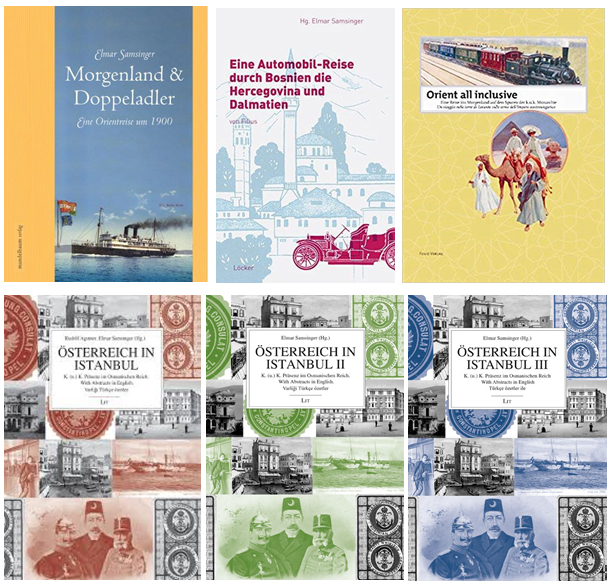
The Interviewees

Interview with Elmar Samsinger, June 2020
1- You studied law rather than history and you have been a judge of the Austrian Federal Administrative Court since 2014. So what started your initial interest in the Austro-Ottoman relations and the Austrian community in the Ottoman Empire?
I first traveled to the Orient - to Istanbul - with my then girlfriend in 1975. An experience, the bazaar, the mosques, a dancing bear, an experience from 1001 nights. Automobile trips to southern, central and eastern Anatolia followed quickly. In the next years I traveled to Syria, Jordan, Egypt, Palastine, Lebanon, Iran and Iraq, to the Caucasus, Central Asia, India and China. Greece and the Balkans were closer destinations. The immediate bridges to the Orient created trips to Bosnia-Herzegovina, Albania and Kosovo. Mostar, Travnik and especially Sarajevo clearly showed that Islam is part of European history. I read a lot of books on the subject and built up an impressive library. I brought kilims with me from my travels, oriental jugs and plates, hamam sandals, jewelry and much more, I bought Afghan furniture from an Afghan friend in Vienna, and I found a few goodies from junk dealers. My apartment was rapidly becoming an oriental camp. I also had the oriental images of 19th century Europeans in mind.
2- You have published a 3 series book (2010/16/18) on the Austrians in Istanbul. How long did the research take place, what were your principal sources of information and how did you limit the time and ‘ethnicity’ factors of this community?
My first book, Morgenland and Doppeladler: Eine Orientreise um 1900 (The Orient and the Double-headed Eagle. An oriental trip around 1900) was published in 2006. I dealt extensively with the oriental travel boom in the late period of the Monarchy. The initial spark for this was the exhibition Mit Szepter und Pilgerstab (With Scepter and Pilgrim Staff), in which the role of Austria in Palestine/Israel was comprehensively presented. In the exhibition I came across some copied pages with postmarks that bore surprising inscriptions: Austrian Post Constantinople, Smyrna, Beirut, Jerusalem, Alexandria. I couldn’t explain it to myself and started doing research. The topic was found and there were many questions: Who traveled to the Orient around 1900, were there travel guides, how did you get there, what was the cost of a trip, were there hotels ...? I did this research for 6 years and learned the basics about how Austria in the Levant worked out. In the same year I was lucky enough to curate the ‘Orient all inclusive’ exhibition in South Tyrol at the Meraner Touriseum - the Louvre of tourism museums in Europe. I wrote the accompanying book, a travel diary of a fictional trip to the Orient around 1900. The exhibition was also shown in Trieste. The exhibition was very popular.
In 2009 I asked my good friend Rudi Agstner, diplomat and historian, what the Austrian Ministry of Foreign Affairs is planning for the Capital of Culture Year Istanbul 2010. His answer: “Well, what do you think, nothing of course.” We then brought together a team of researchers who, with us, wrote treatisis to Volume one of Österreich in Istanbul. K.(u.)k. Präsenz im Osmanischen Reich (Austria in Istanbul. K.(u.)k. [kaiserlich und königlich = imperial and royal] presence in the Ottoman Empire.
We were very grateful to the prominent authors for delivering excellent essays in just 10 months and free of charge. Rudi contributed three, I two essays. Rudi then put the manuscript on the ministry’s desk, which ultimately financed the printing. The book was a success. The publisher then approached us in 2014 whether we could imagine an extended new edition. We could and soon found a lot of new material. Unfortunately Rudi passed away unexpectedly in 2015 and I then finished volumes 2 and 3 myself and wrote the majority of the contributions.
The focus of the volumes is in the 19th and early 20th centuries until the First World War. However, individual contributions also deal with the time before and after. The focus of the investigations was the very complex Austrian (+Hungarian) consular-community in Constantinople. Levantines and Ottoman subjects hardly occur. Our view of the community is thus a pure inside view. Certainly the Turkish view of the Austrian colony would also be very interesting. I hope that Turkish historians will one day accept this topic.
The main sources were the Austrian State Archives (HHStA) and the online newspaper archive of the Austrian National Library (ONB ANNO). We and our co-authors naturally used numerous other sources.
3- What made the Austrian community in Constantinople so special? Is it fundamentally different from consular-communities in Paris or London?
The k.(u.)k. (imperial and royal) consular community in Constantinople was indeed something very special. With 10 to 20,000 members, it was the largest municipality of the Austria Empire (until 1867) and the Double Monarchy Austria-Hungary (until 1918) abroad. The Austrian(+Hungarian) ambassador had his official seat in Constantinople, which even had its own state yacht. Due to the capitulations, the Austrians had rights in the Ottoman lands like in no other country - freedom of employment, tax exemption, protection from the k.(u.)k. consulate and Austrian jurisdiction - and all for a small matriculation fee.
The consular community in Constantinople had a complete Austrian administrative and judicial structure. Hospitals, churches and schools were available, and there was also a well-organized aid-association for the needy. The k.u.k. Consulate kept the civil status and commercial register, arbitrated and decided in disputes, issued passports and residence permits, conducted estate proceedings and much more. The k.u.k. Consuls had considerably more powers in Ottoman cities than ambassadors in other countries. A special feature that benefited business people in particular was the presence of a k.u.k. Chamber of Commerce and the Austrian Levante post offices. In Constantinople there were two other offices in addition to the embassy post office. Not to forget the Austrian Lloyd, the largest shipping company in the eastern Mediterranean. The ships of the Lloyd established regular traffic between Trieste and the Levantine port cities and islands to Alexandria. Steamships also continued through the Suez Canal to India and Japan.
The three volumes of Austria in Istanbul cover all of these topics, and there are English and Turkish abstracts on the contributions. Of course, full-text output in these languages would make sense, but who pays the translation costs of 1,500 pages? The comparison with the consular communities of the other major powers in the capital of the Ottoman Empire and the relations with Levantines and Turkish subjects would be particularly interesting.
4- For centuries the Ottomans were at war with Austria and on an occasion the Turks came close to capturing Vienna. From when was it possible for relations to be normalised for a Hapsburg merchant community to develop in the Ottoman Empire? Did Austria have similar generous capitulation privileges akin to that of England, France, Holland etc.?
Indeed, the relationship between the Habsburg emperors and the Ottoman sultans has not been easy for centuries. After the conquest of Byzantium 1453, the Ottomans pushed west. Her opponents were the Republic of Venice at the sea and the Austrians on the Balkans and in Hungary. The rush of the Ottomans was shattered in 1529 and 1683 on the city walls of Vienna. In 1683 they almost conquered the capital of the emperor, the relief army under the Polish king Sobieski appeared at the very last moment. As a result, imperial armies under Prince Eugene gradually pushed the Ottomans ever further back, Hungary was liberated, and in 1717 Belgrade fell into Austrian hands.
With the Peace of Passarowitz in 1718 between the emperor and the sultan, Austria achieved the greatest territorial expansion in its history. The Habsburg Empire became a major power in Central and Eastern Europe through the Turkish wars. After the peace treaty, trade agreements were also concluded on the basis of which Austrians and Ottoman subjects enjoyed freedom of trade in the other area. As a result, Austria received and surrendered the same rights as the other great powers with the Ottoman Empire. Of course there were still wars afterwards, the last one ended in 1791. A serious disruption of the Austrian-Ottoman relationship brought the occupation in 1878 and the annexation of Bosnia-Herzegovina in 1908. Otherwise, the relations were mostly quite good. The Ottoman Empire entered the First World War in 1914 on the side of Austria-Hungary and the German Empire.
But Austrian-Turkish relations were not only shaped by armed conflicts. With the disappearance of the serious threat, the Ottoman Empire also held great fascination in the 18th century, a true Turkomania broke out. Mozart composed the famous Turkish March, there is a picture of Empress Maria Theresa wearing Turkish clothing. Conversely, the Marie Theresien Thaler was a popular means of payment in the Orient until the 20th century. The coin enjoyed great trust because of the constant silver content, the stately bust of the empress on the front of the coin was certainly not harming either for this reputation. The Vienna World Exhibition in 1873 was designed as a Window to the Orient, and the Ottoman Empire was prominently represented here. Emperor Franz Joseph previously visited the sultan on his journey to the opening of the Suez Canal in 1869. Even the emperor could not escape the fascination of the Orient. The sultan had given him his palace and Franz Joseph wrote to his wife Elisabeth: “We are experiencing a fairy tale from 1001 nights here.”
5- Did the Austrian/Hungarian community of Istanbul survive, did Austrians return post the establishment of the Turkish Republic in 1923?
In 1919 the German and Hungarian elites of the k.u.k. Consular communities were expelled from Constantinople - members of other nationalities joined the successor states of the monarchy. Almost nothing remained of the thriving Austrian colony in Constantinople.
On January 28, 1924, the Republic of Austria, founded in 1919, concluded a friendship agreement, a settlement agreement and a contract with the Turkish Republic, which had just been proclaimed by Mustafa Kemal Pasha in 1923, and a contract that comprehensively regulated mutual economic relations. So this date can be seen as the date of establishment of diplomatic and consular relations between these 2 reconstituted nations. In the summer of 1925, Mehmed Hamdi Bey was appointed Turkey’s first envoy to Austria, and stayed until 1934.
As early as 1924, the Austrian government sent the former k.u.k. Consul General in Smyrna and Salonica, August Ritter von Kral as the first ambassador of the Republic in Turkey. On Kral’s initiative the Association of Austria was founded in Constantinople / Istanbul in 1925. At that time the colony had only 160 members. To promote economic relations, a pioneering initiative was set up in 1923 by founding the Austrian-Oriental Chamber of Commerce to reactivate the old relations between Austria and the Muslim countries. At the end of 1925, the Austrian-Oriental Chamber of Commerce had 150 members, including a large number of Turkish companies.
The new Austrian-Oriental Chamber of Commerce also placed specialists in Turkey. The Mustafa Kemal Ataturk government was specifically looking for foreign specialists from business, science and culture to help them build a secular European state in the spirit of Ataturk’s Kemalism. The great need to catch up and the prevailing spirit of optimism therefore also attracted many Austrians from the post-war sadness of their homeland to the newly founded Republic of Turkey. According to the census of October 28, 1927, 1,435 Austrian nationals were in Turkey at the time. Until foreigners were banned from working in most sectors in 1932/34, numerous technicians and craftsmen, engineers, foundries, metal workers, teachers, but also forest specialists found work in Turkey. Railway construction in Anatolia also offered opportunities in that sector. Quite a few women came to work as educators or nurses.
The work of some Austrian architects and visual artists proved to be more sustainable than the economic commitment of domestic companies in the emerging Turkish Republic. Special mention should be made to Clemens Holzmeister, whom Ataturk entrusted with the construction of his new capital, Ankara.
Unlike labor migration in the first decade of the Turkish Republic, the influx of Austrians and Germans in the 1930s was political and racist. When Hitler came to power in 1933 in Germany and in 1938 in Austria, many prominent Jewish scientists were forced to flee abroad, preferably to Turkey. And Mustafa Kemal welcomed them with open arms to help reform the academic education system. The professors fired by Austrian and German universities found new places of work at university chairs, institutes and clinics in Istanbul and Ankara.
6- Were you able to connect with any descendants of this community in Turkey or Austria?
The focus of my research lies in the 19th and beginning of the 20th century, my sources are essentially historical. I only found very few descendants of Austrians in the Levant, I found some older stories in the literature, none of which were really contained an abundance of information. The number of German-speaking Austrians in the consular communities was relatively small, so there are probably only a few descendants today who could report something. The time was too long ago and I wasn’t really looking for it.
7- How unified was this community in Istanbul – did the tensions with Hungarians or Jews in Austria also manifested themselves in Ottoman lands as well?
The Austrian colonies in the Levant mirrored the problems of Austria-Hungary on a small scale. Cohesion was therefore usually not particularly good.
The center of the k.(u.)k. Consular community formed - especially pronounced in Constantinople - a small, socially and economically influential elite around the consulate general. These were bankers, bulk merchants, landowners, the agents of the Austrian Lloyd and branches of banks and insurance companies, the k.k. Post office manager, doctors and lawyers. They had, at least in part, German as their mother tongue, as did the German Bohemians in the colony.
In contrast, the ordinary people - shopkeepers, artisans, warehouse, port and farm workers, domestic workers and many other bread professions - were dominated by the South Slavic languages of the Dalmatians and Istrians as well as Italian. Until the loss of Veneto and Tuscany (Habsburg branch line) in 1859 and Lombardy in 1866, Upper Italy belonged to the Habsburg Empire. In the course of the unification movement in Italy, these Italians fell under the consular protection of the Regno d’Italia proclaimed in 1861. The establishment of the Prussian-dominated North German Confederation in 1866, which was completed in the unified German Empire in 1871, brought about a similar development. In Smyrna, Beirut, or Cairo, Prussian consulates quickly became Imperial German representations. Citizens of the southern German states, who were under Austrian protection were effectively comrades in the Levant due to the lack of their own consular mission, and were now subordinate to the Imperial German Consuls. However, some Levant residents from Catholic Bavaria, Württemberg or Saxony remained under k.u.k. Consular protection. In addition, there were a few ‘Austrians’ under Swiss protection who, however, were happy to remain under that status. The diversity of nationalities in the Austrian colony also shows in their surnames.
As opposed to German Austrians, ethnic Hungarians were few and far between in the consular community in Smyrna. The numerous Magyar 1848 revolutionaries in the city were in hateful opposition to the Habsburg Empire and found support from foreign consuls. The Sultan refused to hand them over to Austria, and quite a few entered the Ottoman civil service. As a result, the Hungarians proudly cultivated their Magyarism and drew clear boundaries with German Austrians and Hungarian slaves in Austria-Hungary.
Austrian Jews formed a significant part of the consular community. In the beginning, many of these came from the Habsburg Grand Duchy of Tuscany, especially from Livorno. They were later followed by Galician and Hungarian Israelites. In view of the nationally, economically and socially amorphous nature of the Austrian communities in the Levant, the annually celebrated imperial birthdays were often the only reason for commonality and patriotism.
This mix of nationalities led to the complete disappearance of the Austrian colonies within a few weeks after the First World War was lost. In Constantinople, this numbered considerably more than 10,000 heads, in Smyrna, for example, there were more than 2,000. The German elites were expelled and the Italians, Czechs, Hungarians, Croats, Slovenes etc. immediately submitted to the successor states of the defeated Habsburg monarchy to obtain their new citizenships. Levantine de facto subjects turned to the embassies of the victorious powers and asked for admission as citizens.
8- Could you tell us a bit about the influential members of this community and their legacy?
An embassy interpreter, a Bohemian glass merchants, a murdered imperial and royal regiment doctor, a ladies’ orchestras from Vienna, and several who rose to become Pashas and Beys from the Habsburg Monarchy – all of them wrote more or less significant life histories in the capital of the Ottoman Empire. Their fates highlight life in the Austrian colony in Constantinople.
The letters from Theodor Ritter von Schwarzhuber provide a clear picture of the Ottoman Empire in the middle of the 19th century from the viewpoint of an interpreter for the imperial and royal Habsburg embassy. His surroundings differed substantially from those of the girls and young women who sought their fortunes along the Bosphorus as maids, cooks, waitresses, vendors, musicians, or in many other professions. All of them were driven to the Orient by economic hardship, and today we would categorize them as economic migrants. For not a few of these young girls their adventure ended tragically: they landed in one of Constantinople’s many brothels. The trafficking of girls and women from the monarchy was a big problem which even the Austro-Hungarian government concerned itself with – however with little success.
The occupation of an Austrian doctor along the Bosphorus was at times no less dangerous; poor hygienic conditions and epidemics drove away not a few physicians from the Habsburg Monarchy. An imperial regimental doctor also fell victim to murder, perpetrated by the embittered father of an irrecoverable daughter. The most famous physician of the Austro-Hungarian Empire was Dr. Carl Eduard Hammerschmidt/Abdullah Bey from Vienna, who also co-founded the Türkischer Roter Halbmond (Turkish Red Crescent). Doctors from Austria had previously set up a quarantine station in the Ottoman Empire. A handful of young military doctors were summoned to Constantinople by Sultan Abdülmecid I in 1840 to reform the military hospitals. As a result, they set up the college in Galatasray and laid the foundation for modern medical science in the Ottoman Empire. The State Chancellor Metternich saw the young doctors as an opportunity to strengthen Austria’s influence in Turkey. Indeed, several of these doctors became personal physicians to the Sultan and his family. The State Chancellor obtained first-hand information from them. Unfortunately, this strong position in the medical field was lost again due to the lack of interest and sloppiness in Austrian foreign policy.
Bohemian glass merchants, who operated successfully in Constantinople from the 17th century, provide insights into the economic life there. A significant chapter in the relations between the Austro-Hungarian Empire and Constantinople was written by officers and soldiers from the Imperial Austrian army. After the Revolution of 1848, many Hungarians and Poles fled from Emperor Franz Joseph’s henchmen to the Ottoman Empire, where not a few of them made their careers. Mihajlo Latas, who came from what is now Croatia but was of Serbian descent, was especially successful and climbed the ranks all the way to the title of Serdar-ı Ekrem (Grand Vizier).
Even today the Istanbul firefighters acknowledge grateful remembrance to the founder of the modern fire department in Turkey, the Hungarian count Edmund Szechenyi Pasha. Through his commendable work, large fires which destroyed entire neighbourhoods during the 19th century became a thing of the past. The upcoming chapter portrays a series of personal histories from inhabitants of Constantinople from the Habsburg Monarchy through the use of contemporary sources.
Finally, the Baltazzi and Camondo banking families should be remembered. Levantine and Jewish bankers and successful wholesalers were generous supporters of the poor amongst the Austrian colony in Constantinople. It was only through their financial generosity that welfare institutions, schools and hospitals could be maintained.
9- What were your chief sources of information, where are the archives kept and are there personal recollections and memoirs included in these paper files?
The main sources of my publications are the files of the k.u.k. Embassy and Consulate Archives of Constantinople in the Austrian State Archives / HHStA in Vienna. The holdings came to Vienna in the early 1920s after the First World War was lost. The inventory includes more than 2000 archive boxes. So far 1000 have been inspected, the remaining 1000 are still waiting to be discovered. In 2020 I started to look through the unprocessed inventory and to create short tables of contents for the archive boxes. There are wild stories about these archive boxes, they are said to contain vials with plague and cholera bacteria. A good story in times of Corona, but only a story.
The second main source is the online newspaper archive of the Austrian National Library. So far over 10 million newspaper pages from 1689 to 1950 have been scanned, an information treasure! In order to use the inventory successfully, however, I have researched several thousand hours in recent years. You can also find a lot in Google, not least on the website of the Levantine Heritage Foundation. 😊
The documents in the state archive are usually official in nature. However, reports from consuls also provide private insight, especially about the internal operations and staff. Personal fates in particular also reflect inheritance and court records. So far I have not found diaries and the like. Gossip and intrigue can be found in some ANNO newspaper articles. All in all, in the three volumes of Austria in Istanbul, I was able to give a colorful insight into the reality of life for Austrians on the Bosphorus.
10- Is there still a semi-permanent Austrian presence in Istanbul and do they have an ongoing cultural calendar?
The Republic of Austria has a Consulate General in Yeniköy on the Bosporus and the Austrian Cultural Forum - a small Goethe Institute - for over 50 years. The focus of this institution is to promote cultural and scientific cooperation between the two countries and to convey a modern and cosmopolitan image of Austria. This happens with over a hundred cultural events a year across Turkey. The Austrian Cultural Forum co-operates with a number of Turkish institutions and universities. The activities range from exhibitions, classical music concerts, dance, electronic music, performance, installations to film, literature, scientific conferences and symposia. Since 2011 there has also been an artist-in-residence program for Austrian artists in Istanbul. The Austrian Consulate General and Austrian Cultural Forum are located in Palais Yeniköy, right on the banks of the Bosphorus. The building is surrounded by a large garden with rare trees. The palace was a generous gift from the Ottoman Sultan Abdulhamid II to Emperor Franz Joseph and was extensively restored. Unfortunately, the Austrian Consulate on the Bosphorus no longer has a state yacht available today.
The St. Georgs College in Galata is one of the few relics that have been saved from the past. It dates back to 1889. The school has been able to maintain its reputation as an elite school. Numerous prominent Turks from politics and business have received their school education here. In 2007, the Österreich-Bibliothek Istanbul (Austrian Library Istanbul), which was previously housed at the Austrian Cultural Forum, also found a central home there. The freely accessible Austria Library aims to bring Austria closer to a wider audience with readings, workshops, scientific projects and its book collections. The St. Georgs Verein (St. Georgs-Alumni Association) was founded in Vienna in 2006. Its members are former students of the St. George’s College in Istanbul, which is located in the Galata district. The association aims to deepen the Turkish-Austrian relations in the cultural, political, economic and social areas. In addition, it offers support for young graduates of the college who want to continue their academic education in Austria. Members of all denominations belong to the association, it supports the liberal and undogmatic dialogue of its members. The association also forms an effective network between Austria and Turkey.
The St. Georgs Hospital is right next to the St. Georgs College. It was founded in 1865. In 1893, the Barmherzigen Schwestern (Merciful Sisters), together with a Turkish doctor, opened one of the first children’s hospitals in Turkey, including an eye clinic and poor kitchen. In the period before the First World War, Austrian Barmherzige Schwestern ran four hospitals in Constantinople. In 1927 a new building for the St. Georgs Hospital was built. With the connected departments for internal medicine, surgery and ear, nose and throat diseases, the hospital was now able to meet all requirements. Refurbished from 1995 to 2000 and expanded again in 2013, the St. Georgs Hospital has an excellent reputation and treats more than 70,000 patients a year. The Barmherzigen Schwestern of the Province of Graz-Central Europe are still responsible for this institution. Medical care for patients is in the hands of competent Turkish specialists and well-trained nurses. St. Georgs Hospital is the only remaining religious hospital in Istanbul.
The AussenwirtschaftsCenter Istanbul (Foreign Trade Center Istanbul) of the Wirtschaftskammer Österreich (Chamber of commerce Austria) assists companies that wish to operate in Turkey. Austria has been one of the most important direct investors in recent years. Turkey has developed into a kind of China on the Austrian doorstep. With a total foreign trade volume of almost 3 billion euros, economic relations are of considerable importance for both republics. Before the Corona crisis, many Austrians also chose Turkey as their holiday destination, and brought Turkey considerable income. All of these relations are a positive counterpoint to the currently tense political relations between Austria and Turkey.
11- The Jewish clothing company A. Mayer & Co. founded in the Bratislava ghetto in 1830 was able to spread with branches right across the Levant from the late 19th to the early 20th century. There were also stores of the company in Constantinople. What was their secret that made them so successful?
I reviewed this Jewish family and company history in 2015 in the book Fast wie Geschichten aus 1001 Nacht. Aus dem Leben der jüdischen Textilkaufmannsfamilie Mayer in Europa und im Orient. (Almost Like Stories from 1001 Nights. From the life of the Jewish textile merchants Mayer in Europe and the Orient.) It was probably my most successful publication so far, the book was published in Turkish and in a small private edition in Hebrew. Maybe there will be an English translation at some point.
The book was possible because Sigmund Mayer, the son of the company founder, was very literary and wrote two books about life in the ghetto in Bratislava and the rise and role of Jewish merchants in Central Europe. Unfortunately he hardly wrote anything about his clothing company A. Mayer & Co. The company originated in the Bratislava ghetto. Salomon Mayer and his wife ran a small textile shop here in the 1830s. Salomon established himself in Vienna in 1856, where he opened a cloth trade. 1866 his sons Sigmund and Albert relocated the company’s activities to the Orient. The headquarters stayed in Vienna and the production was in Boskowitz/Boskowice, while in Constantinople, Alexandria, Cairo, Port Said and Salonica large clothing stores were opened. The company flourished for decades until the First World War. The branch in Salonica burned down in 1917, the ones in Cairo and Alexandria were sequestrated 1916/17 by the British as an enemy capital. Port Said only existed for a few years. In Constantinople, A. Mayer & Co. had three branches at different locations, only one survived until 1971, when Georg Mayer the last owner of the shop, finally closed the company’s doors. Georg sold the company headquarters in Vienna shortly before the National Socialists came to power.
Practically nothing has survived from the company, some photos, postcards and letterheads. However, I was able to reconstruct the company’s history quite comprehensively from various other sources, especially the estate files in the Vienna Archives. And then there was Adelheid Mayer, Georg’s wife, who was over 80 at the time. She had a fascinating life story herself. Adelheid could not tell me much about the company, but about her husband and his life. And she gave me a booklet written by Georg with short stories about his life as a merchant in Istanbul from the 1920s to the end of the company. Georg was also good at writing and the stories are a fascinating Levantine testimony. I have published them again, along with some unpublished stories, in my Mayer-book. Georg’s stories were also published in Turkish years ago.
A. Mayer & Co. was a clothing retailer for men’s clothing. Sigmund and his brother Albert quickly responded to the demand for Western clothing in Egypt in 1866, and later in Constantinople. The background was the rapid modernization of the country and the increasing influence of Europe in the country on the Nile. The company’s customers were Europeans, but mostly Levantine. They produced cheaply and adapted to customer demand. And they sold in their own shops, everything remained in the hands of the family. In addition to Mayer, there were several other successful Jewish clothing companies from Austria in the Levant, S. Stein, Victor Tiring & Söhne, Goldenstein, Orosti Back. They all worked in the same pattern. In addition to sugar, paper, glassware, matches, beer, oriental caps (Fez) and some other products, ready-made goods were Austria’s most successful export products in the Levant. Unfortunately, exporters from Austria-Hungary were not expeditious enough to use their export chances. Therefore, the monarchy never achieved the position in the Ottoman Empire that it could have had due to its geographical proximity.
12- Do you plan to extend your research later to other cities in the Levant that had a significant Austro-Hungarian presence?
So far, three volumes have been published on the presence of Austria-Hungary in Constantinople/Istanbul. In 2020 two volumes Von Saloniki an den Nil (From Salonica to the Nile) will appear. There are chapters on Beirut, Smyrna, Jaffa/Jerusalem, Alexandria, Port Said and Cairo. Of course, even with a length of more than 800 pages, I could only give an overview. Nevertheless, one can already see that each Austrian colony had its own profile, which of course was strongly influenced by the elites and the structure of the community.
Last year I received an order from Izmir / Smyrna on the subject. Austria in Smyrna will appear in 2021. During this work I was able to get a much deeper insight into this consular community. This was far less densely organized, there was no fixed charity, no chamber of commerce, but there were churches, schools and hospitals. They were led primarily by Franciscans and Mechitarists and enjoyed k.u.k. Consular protection. Smyrna was also important as a Levant base of k.u.k. station ships.
In the next few years I plan to write volumes on Austria in Alexandria and Salonica, inshallah. Both Austrian consular-communities were probably more important than those in Smyrna. I see all these books as quarries that are ready to be mined further. There is still a lot to explore. Unfortunately, there is not much interest in this small but fine section of Austrian history, but you shouldn’t give up hope!
Interview conducted by Craig Encer
Additional material provided by Mr Samsinger, an article titled: ‘A Prince Charming in Wonderland – Constantinople in May 1918’.
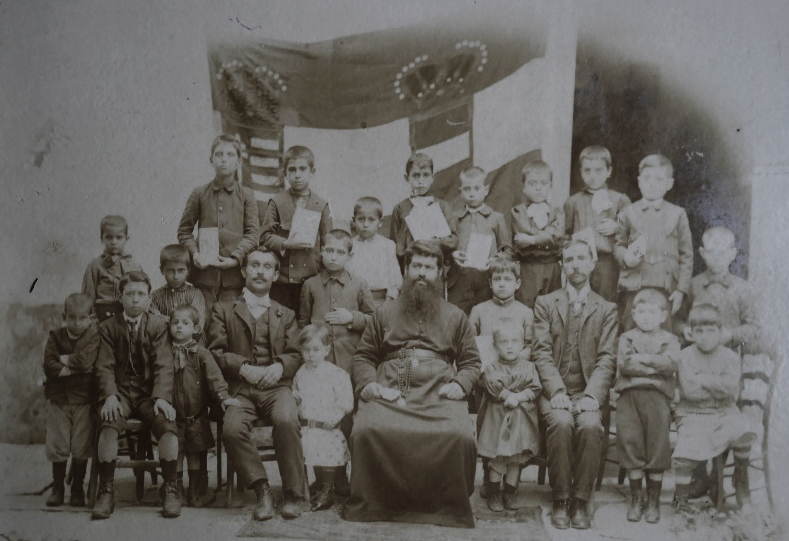
School of Mechitarists in Smyrna around 1900. In the background the flag of the k.u.k. Consulate. (Mechitaristen Wien)
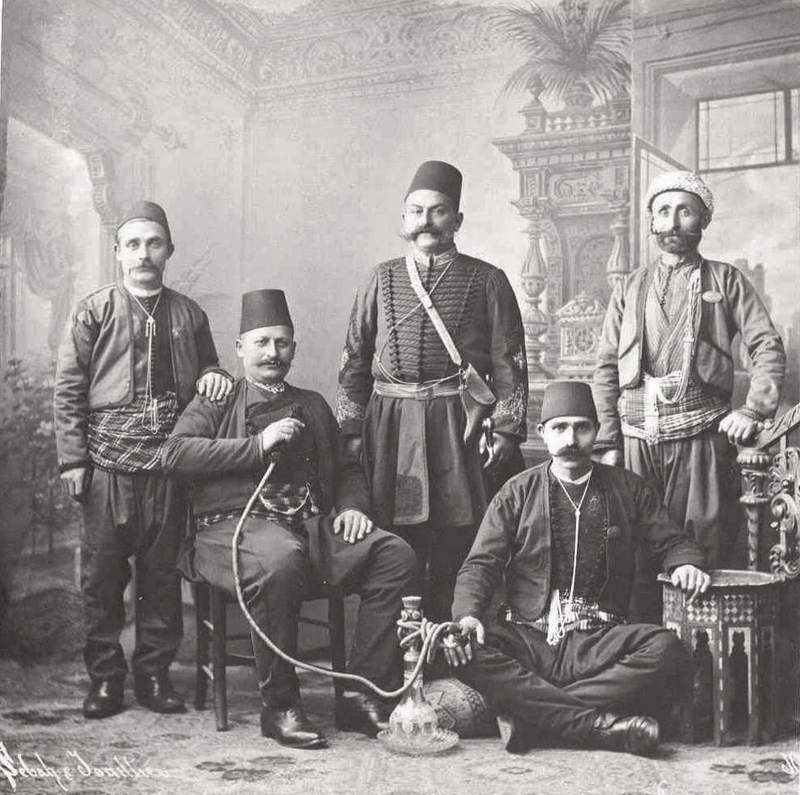
K.k. Austrian postal officials in Turkish outfit in Constantinople (Patera estate)

K.u.k. Consul Ludwig Ritter von Zepharovich (Zepharovich)
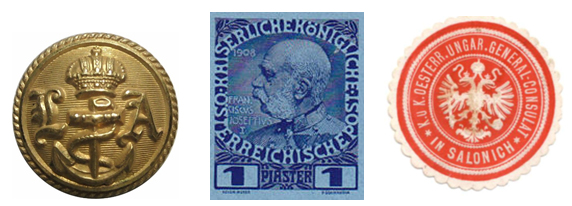
Uniform button of the Austrian Lloyd shipping company – Piaster-stamp of the k.k. Levante-Post – sticky label of the k.u.k. Consulate General in Salonica.
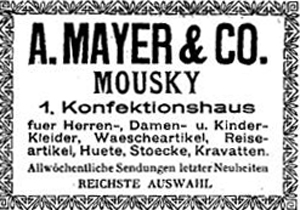
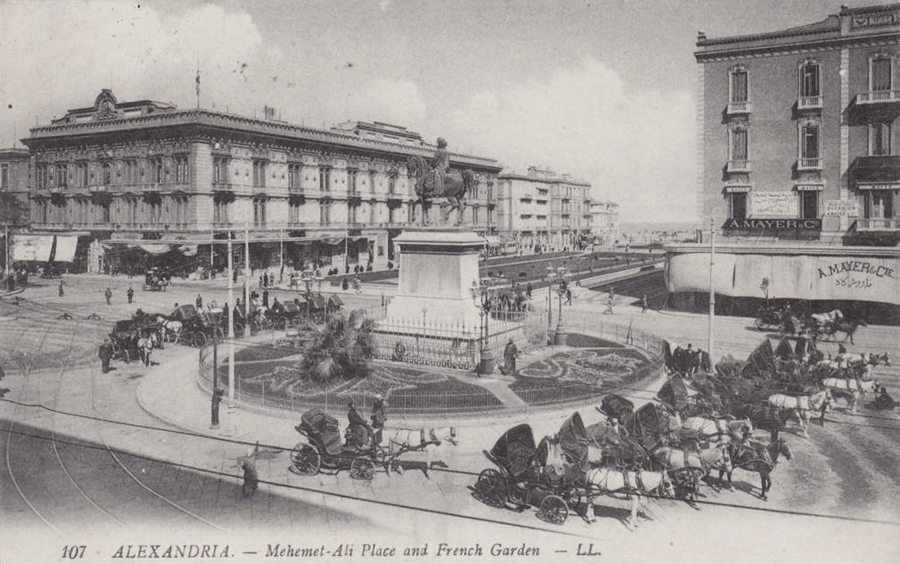
Advertisment in Cairo for the Mayer shop and a view of a branch of this company in Alexandria, Egypt from a postcard, showing its prime location.
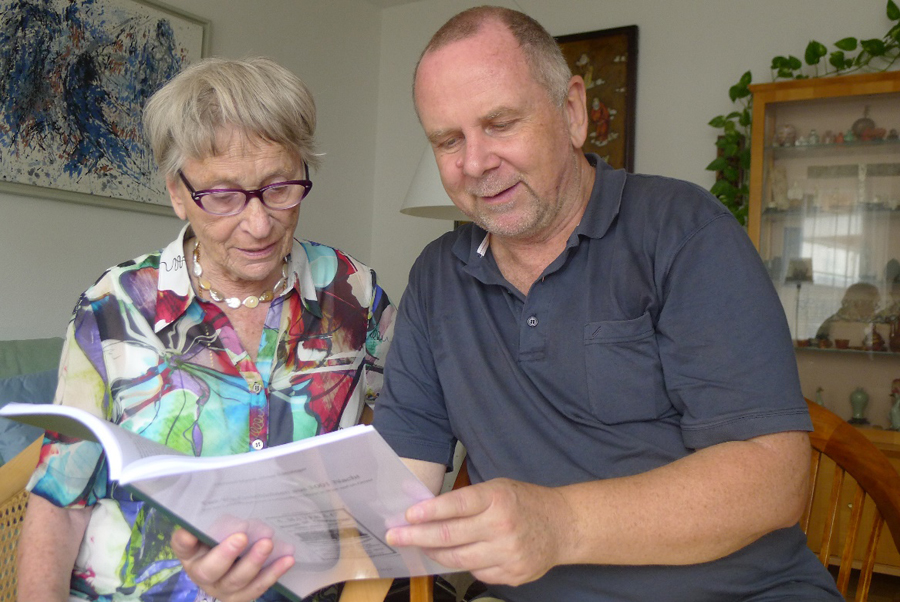
Adelheid Mayer and Elmar Samsinger in August 2014 in Berlin
